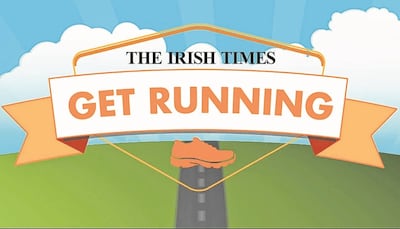
The Vhi Women's Mini Marathon is a virtual event again this year, for, unfortunately, obvious reasons. The popular women's 10km event, which usually sees thousands of women descend on south Dublin to run for various charities, will be entirely virtual for participants to run on their own terms on Sunday, September 19th.
Irish Olympic athlete David Gillick has designed training plans for participants, whether they plan to walk, jog or run. He has given us some tips on how to prepare for the race, keep the motivation going and what to wear.
“We’ve worked on a 12-week programme leading into September 19th. It’s giving people ample time to build the habits, build the routines, and start off small,” says Gillick. “That’s the key thing, start small and build over time.”
“Sometimes the danger is we leave it to a couple of weeks out and then we go for a run or a jog and you might be a bit rushed or not conditioned enough and the negative of that is you might run into injuries. I’d always say to people start early and give yourself a bit of time.”
If you’ve just signed up to the race don’t worry, there is still plenty of time to get in those training sessions – you have almost seven weeks to get ready. You can still join the plan, just shorten the distance of the weekend run until you feel ready to take on the longer distance.
How to get started and stay motivated
Sign up – First of all, sign up to the event. Give yourself a bit of a challenge, pin your stripes to this and say you are going to do it.
Find accountability – Whether that is with a friend, a colleague, a family member or a training group, find someone to do the event with. With social distancing this might be a challenge but accountability with someone will keep you on track.
Get your kit on – If you can just get changed into your sports gear you are halfway there and then you might as well go and do it.
Start small – Getting out of the house can be the biggest challenge. Even if you don't feel like it, remember you will feel ten times better when it's all done.
Organise your calendar – Put your training sessions into your calendar so they fit your timetable, giving you a structure and they are non-negotiable.
Who are you doing this for? – Try to remind yourself why you are doing this event. Is it for yourself, a charity or a loved one perhaps? Hopefully, that will give you the motivation to get out the house and train.
How to jog or run well
Build during your training – You might begin by jogging for a minute and running for a minute for 10 reps. You could also do this with lampposts or trees to get rid of the monotony and but keep challenging yourself as well.
Use your local pitch – If you have a local pitch you can avail of, run the length and walk the width. What that is doing is building cardiovascular endurance, getting the body conditioned to move a little bit quicker but you are also having adequate breaks. The surface will be softer too for your joints and muscles.
Mind your posture – Keep your head and your chest up, pull up your pelvic floor, get your hips nice and high; when you run you always want to be as tall as you can. When people get tired, they tend to tilt forward and as a result you block your stride and don't get that knee lift. This is where running intervals are good because you can realign your posture in between.
Fuelling and hydrating for race day
Hydration is important – Try to increase your hydration leading into the day. The week before be aware of how much you are consuming daily, it should be in and around 2 litres anyway and again if you are exercising add more to that.
Sips of water are best – Don't guzzle pints of water at a time because you'll just end up having to go to the bathroom; sip away on your water.
Add electrolytes – If you sweat a lot you should be adding electrolyte power or tablets to some of your water to replace the essential minerals your body loses through sweat; also worth taking the morning of race day with a pint of water over breakfast.
Hydrating during the race – There are no water stations on a virtual event so why not create your own? Pick a spot of your run route and place a bottle of water behind a fence or tree (please remember to pick up your bottle after the race!). For those who are happy to carry water, take a small bottle or one that fits in a running harness. Carrying a heavy bottle is going to affect your posture, be mindful of that.
Eat well – You don't have to go mad carb loading but in the days leading up to the race increase your carbohydrates with something like pasta or potatoes. Check your vegetable intake, include beetroot, green leafy veg, kale and spinach and get some high-water content fruits such as pineapple and melon into your diet too.
Eat early on race day – Eat at least two hours before your run and don't try anything new on race day.
What to wear
Good shoes – This is one piece of kit you don't want to skimp on. There are plenty of specialist running stores around Ireland who can assess your running gait and get you wearing the right running shoe. Decent runners are an investment for your body's health. Add a good pair of socks and you've got yourself happy feet.
Practice your clothes – The right shorts, running top and even bra are important. Get this stuff well in advance of the 19th. Don't just get it the night before because it might cause discomfort on the day. Wear material that allows for ventilation and if you have areas prone to chaffing, lube up with some Vaseline or an anti-chaffing cream.
Invest in a sports bra – If you haven't added a sports bra to your wardrobe then do it now and get it professionally fitted. A well-fitted sports bra is a game changer for running, your boobs and back will thank you for it.
And most of all have fun!

Sign up for one of The Irish Times' Get Running programmes (it is free!).
First, pick the eight-week programme that suits you.
- Beginner Course: A course to take you from inactivity to running for 30 minutes.
- Stay On Track: For those who can squeeze in a run a few times a week.
- 10km Course: Designed for those who want to move up to the 10km mark.
Best of luck!









